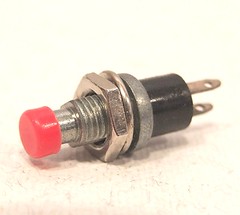Seeing Melbridge Dock at Leamington show prompted Dave to ask:
Question 1: Why do Melbridges' motors change with an understated "thok" rather than a full fat "thwack!"? Are they standard motors, have you modified something or did the acoustics in the hall hide the noise? I was heartened by their quietness.
The point motors used on the layout are all standard Peco items. In our case PL-10 as that was what was available when the model was built, PL-10E (extended pin version) would be better now. Each motor is fitted to an PL-12 adaptor base which provides locking using an over centre spring (Unlike RTR points, handmade track doesn't provide this. With RTR you actually need to remove the adaptor base spring otherwise the motor isn't always powerful enough) and allows us to screw the whole lot to the bottom of the baseboard. Polarity switching is handled by a PL-13 accessory switch. The pins had to be extended to reach the baseboard top with a brass sleeve hence the preference for the 10E version now.
I suspect the noise reduction is due to a number of factors - the model was seen in a hall full of people which always helps reduce the noise, the 9mm plywood baseboards don't resonate much, the motors get DC not AC (see below) and the adaptor bases aren't screwed tightly to the bottom of it. When testing we've always found that the system works better if the screws are slightly lose unless you can drill the holes exactly in the right place and perpendicular to the surface. Get the screws in slightly at an angle (easy to do when working upside down) and the nylon base is stretched or compressed meaning the slidy bit doesn't move smoothly. How tight the screws need to be is a matter for experimentation.
Question 2: What method of switching do you employ? I considered the Peco switches (pretty but difficult to mount on a front fascia), Hornby (show the direction of the point but also hard to fit neatly), stud and probe (don't fancy a dangly thing hanging there) and centre biased "up and down" switches from Modelex, Squires etc.
I am leaning towards the last in this list but wondered what method you employed?
The photo should give you a clue. On the back of the layout we have a track diagram with push switches for each point direction. These are from Squires (PTM190 - P433 in the catalogue) and cost a whopping 30p each. Extra grunt is supplied by a Modelex heavy duty capacitor discharge unit (CDU). This may help with noise reduction as all the power is provided in a burst followed by a lull for a fraction of a second as the unit recharges. Running motors from an AC supply , power flows as long as you hold the switch. AC also causes the motor to buzz slightly unlike the CDU provided jolt of DC.
Whatever you chose, make sure that only a momentary pulse is provided. I suspect Peco switches give this through a clever passing contact arrangement. Sprung toggle switches would do the same but their standard brothers will fry the motor as it can't handle continuous power.
Incidentally, Iain Rice always railed against these cheap switches. In theory they should burn out in use but our experience has been different. The contacts last for many years and some of our have been in use for 20 years.
Finally, if anyone sees the layout at a show, if we aren't busy we'll happily let people have a look under the model to see how it is done.

No comments:
Post a Comment